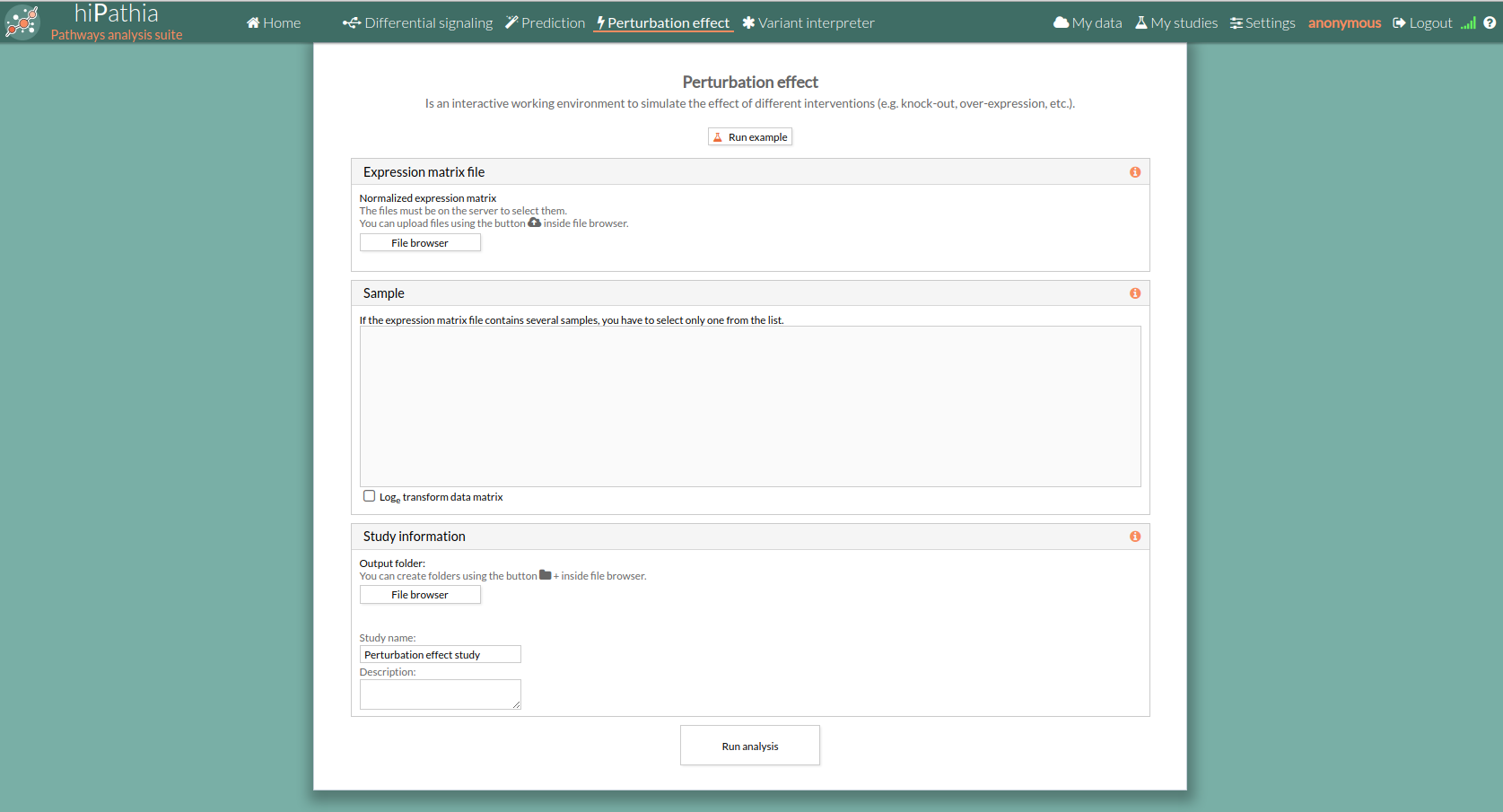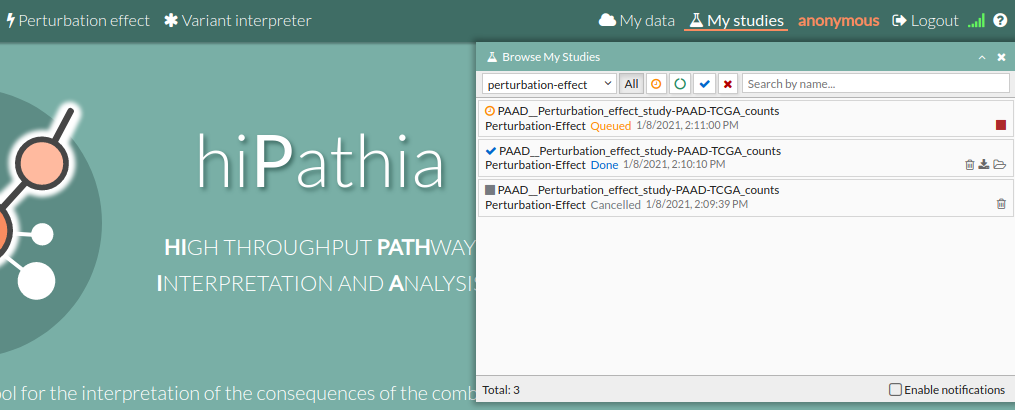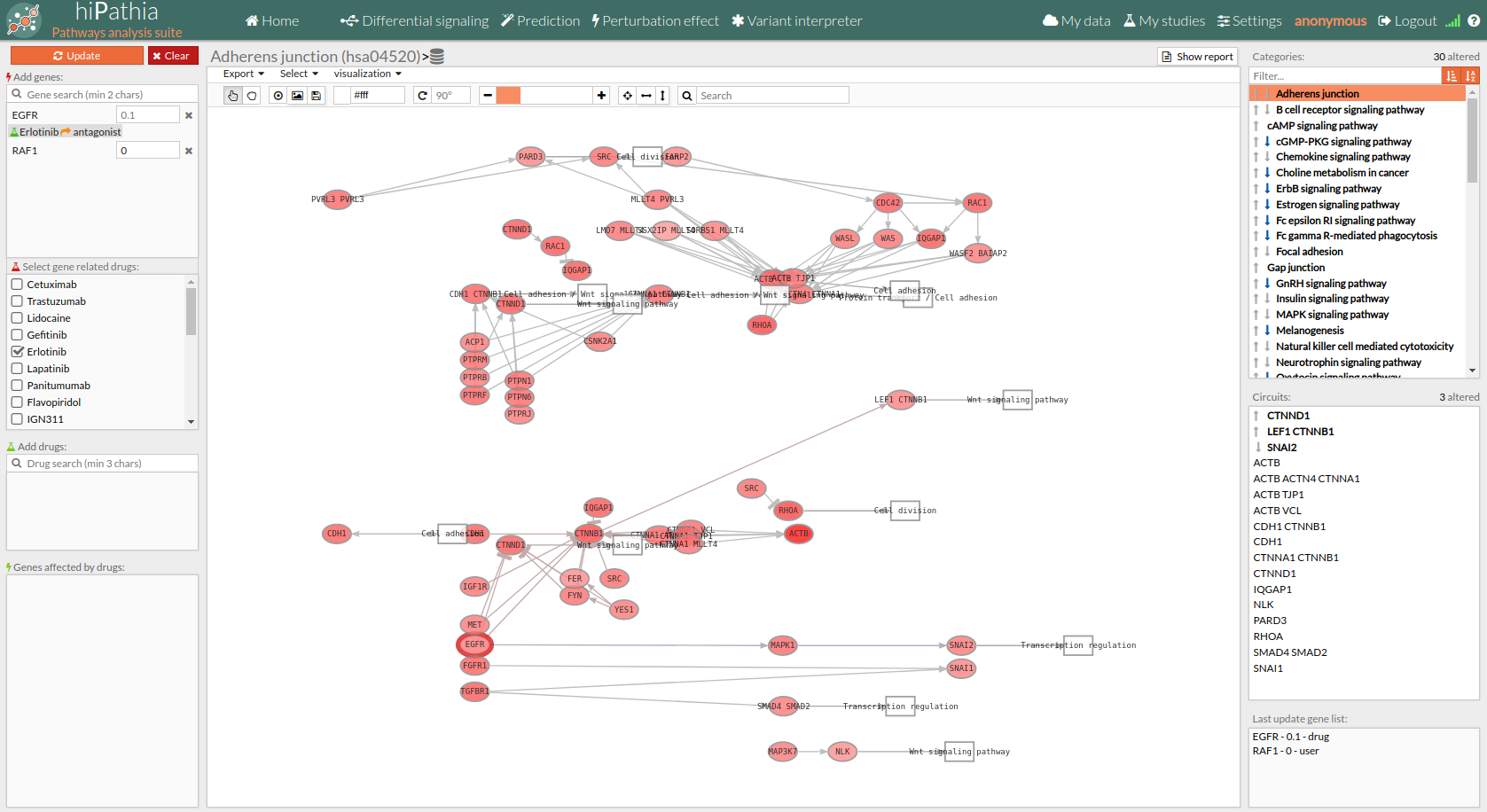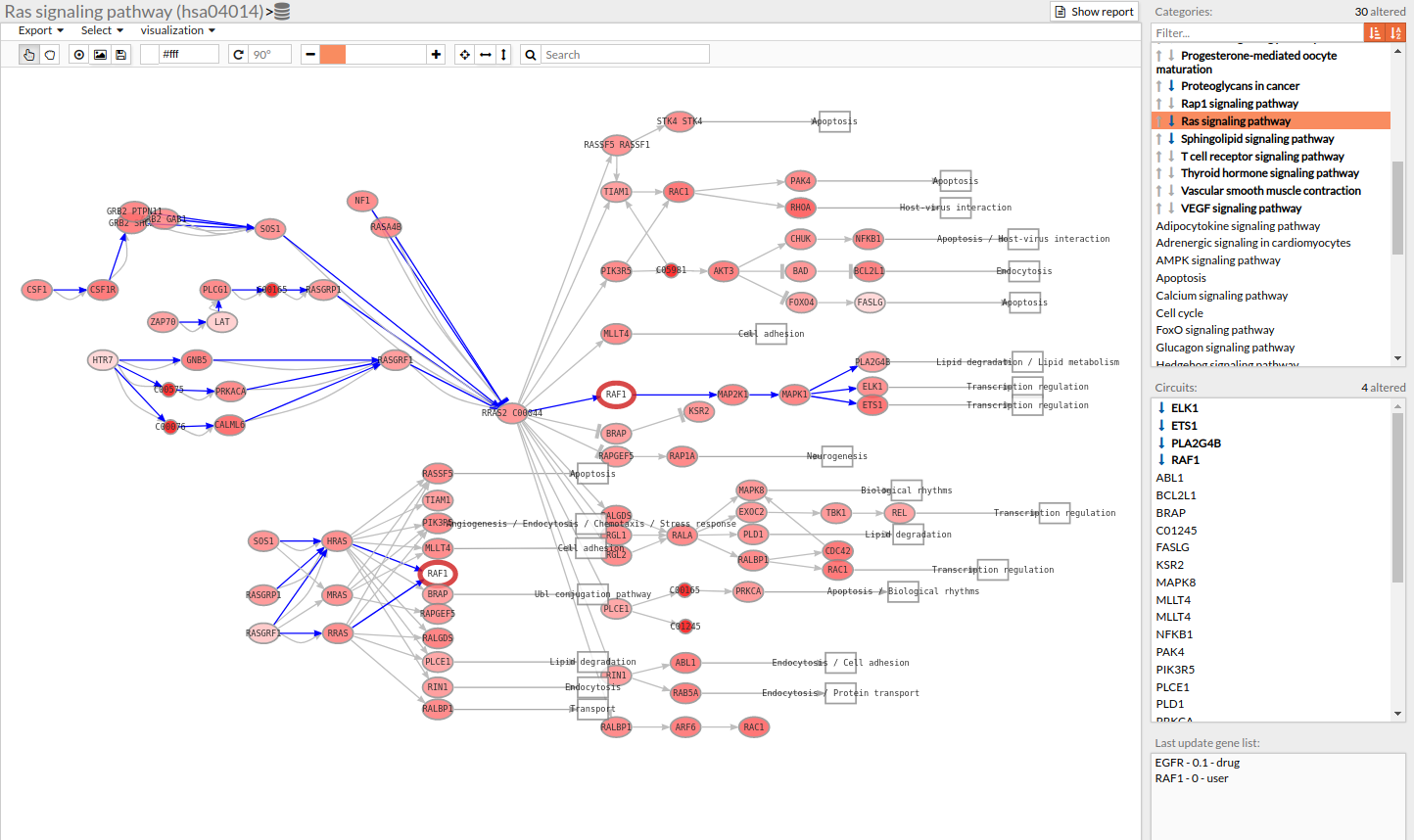Table of Contents
Worked example: Perturbation effect
In silico simulations of the functional effects that drug-induced perturbations would have in the cell are extremely valuable to predict putative therapeutic impacts of drugs or combinations of them. They are also useful to evaluate response inconsistencies and to search for resistance mechanisms. To demonstrate the value of this tool, this example will be focused on the functional impact that the combined inhibition of EGFR and c-RAF (RAF1) would have on pancreatic tumors. To do so, we simulated the effect of Erlotinib (a known and widely used anti-EGFR drug) in combination with the knockdown of the RAF1 gene. This combination has been described to achieve a complete regression of pancreatic cancer in ductal adenocarcinoma derived xenografts induced by KRAS mutation [1].
The drug effect is simulated by multiplying the expression value by the activity factor provided in the settings. To simulate a knockdown, the activity of the target gene is multiplied by the provided knock-down factor. In this example, the effect of Erlotinib reduces EGFR activity to a 10%, while the RAF1 knock-down reduces its activity to a 1%.
Step by step
To reproduce this example, click the Perturbation effect example under the help button.
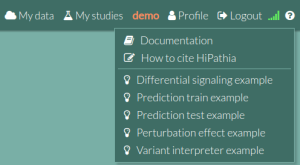
You can also launch a new study by following these steps:
- Log into Hipathia. Click the login button on the top right corner to open the login panel. You can also log in using an anonymous user. Please visit Logging in for further information on this step.
- Click the Perturbation effect tool in the menu to open the empty form.
- Click the Run example button. Alternatively, here si where you could also upload your own gene expression file.
- A study will appear on the My studies panel and will be processed.
- Once finished (Done), click the study name to open the view window.
- The view window will open.
You will notice that the nodes with a thick red outline (as shown in the screenshot below) contain at least one of the knocked-down genes, and those with a thick green outline contain some gene affected by a drug applied.
- Gene perturbations can be studied individually or in combination. This makes it possible to check for potential effects of drug combinations over the activity of signaling pathways.
- To remove an effect, simply click the “X” to its right and the expression levels of the affected genes will return to their original value after clicking the Update button.
- The Clear button removes all perturbations being applied to the signaling landscape of the sample. To restore the perturbations applied in this example:
- Search “RAF1” in the add gene box and add it. Write 0.01 as the knock-down factor.
- Search “erlotinib” in the add drug box and tick the box to its right.
- Remember to click Update to apply all changes.
Results and interpretation
The Perturbation effect tool reproduces the effect of the knock-down or over-expression of a set of genes by comparing the signaling profile of the pathways in the uploaded sample and the signaling values resulting from the modification of the expression values in the current sample by the selected values.
Each time the Update button on the Gene list panel is pressed, a comparison is performed with the modifications present in the Gene list and the Additional drug targets.
Pathways with signaling differences are presented in bold characters in the Pathway list panel “Categories panel”. The up and down arrows indicate that there exist up and down-regulated circuits in the corresponding pathways, respectively. When the up arrow is red or the down arrow is blue, the differences are significant. An absolute fold change greater than 2 is considered significant. Therefore, an absolute log fold change greater than log(2)= 0.6931472 is considered significant.

Circuits with signaling differences are presented in bold characters in the Circuit list panel. The up and down arrows indicate that the circuit is up or down-regulated, respectively. When the up arrow is red or the down arrow is blue, the differences are significant.
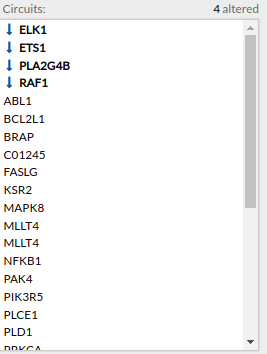
Results can be also visualized graphically in the Pathway viewer. Each time a pathway is selected in the Pathway List it is displayed in the Pathway viewer. The edges of the circuits with a difference in their activation are depicted in different colors.
- Light greyish red: The circuit is up-regulated, but not significantly.
- Light greyish blue: The circuit is down-regulated, but not significantly.
- Red: The circuit is significantly up-regulated.
- Blue: The circuit is significantly down-regulated.
The results can be exhaustively examined and downloaded from the generated report by clicking the Show report button. A new window with the results report for the current comparison will be displayed. This report includes two fields:
- Input: Lists the genes whose expression has been modified in the current comparison, and the new expression value.
- Circuit impact: Lists the names of the signaling circuits (pathway:effector node), ordered by the absolute value of their fold change (also measured as the logaritmic transformation of Fold_Change). An absolute fold change greater than 2 is considered significant. Therefore, an absolute log fold change greater than 0.6931472 is significant.
To close this window and return to the tool page, you can press the close button on the right upper side of the window or the Close button at the bottom of the panel.
Discussion
The combination of the inhibitions has a clear impact on cell mechanisms related to the Hallmarks of Cancer, such as proliferation, apoptosis, and cell adhesion and motility. Among the pathways dysregulated by the perturbations, we highlight the Ras signaling pathway (hsa04014), proteoglycans in cancer (hsa05205), ErbB signaling pathway (hsa04012), and PI3K/Akt signaling pathway (hsa04151). The dysregulation deregulation of these signaling pathways have been described in pancreatic cancer [2] and the in silico inhibition globally reduces the activity and the functions triggered by these, indeed some targets within them are being used to treat pancreatic tumors (such as EGFR, KRAS, TGFB, NFKB, MEK1).
Focusing on the Ras signaling pathway (hsa04014), three circuits appear as inhibited by the knock-down of c-Raf:
- The ELK-1 circuit, which is generally activated in pancreatic cancer [3].
- The ETS-1 circuit. The ETS Proto-Oncogene family (ETS) has been linked to pancreatic cancer progression and, specifically, ETS-1 has been described as potential target reducing angiogenesis and progression in pancreatic cancer [4, 5].
- The PLA2G4B circuit. PLA2G4B is highly expressed in the pancreas and this gene has been described to modulate the sensitivity of pancreatic cancer cells to chemoradiation treatment [6].
Among the most represented effector genes affected by the knock-down simulation, we want to highlight the roles of PLA2G4B, MAPK1, CDKN1A, ELK1, PRKCA, and CAMK2A in processes such as signal transduction, calcium metabolism, and cell cycle regulation. These mechanisms have been highly related to cell proliferation and cancer progression, therefore inactivating the circuits that trigger these effectors would result in a potential reduction in cancer progression, which is consistent with the results observed in Blasco et al. [1].
References
[1] M. T. Blasco et al., “Complete Regression of Advanced Pancreatic Ductal Adenocarcinomas upon Combined Inhibition of EGFR and C-RAF,” Cancer Cell, vol. 35, no. 4, pp. 573-587.e6, Apr. 2019, doi: 10.1016/j.ccell.2019.03.002.
[2] R. V. Iozzo and R. D. Sanderson, “Proteoglycans in cancer biology, tumour microenvironment and angiogenesis,” J. Cell. Mol. Med., vol. 15, no. 5, pp. 1013–1031, May 2011, doi: 10.1111/j.1582-4934.2010.01236.x.
[3] A. Arlt, H. Schäfer, and H. Kalthoff, “The ‘N-factors’ in pancreatic cancer: functional relevance of NF-κB, NFAT and Nrf2 in pancreatic cancer,” Oncogenesis, vol. 1, no. 11, Art. no. 11, Nov. 2012, doi: 10.1038/oncsis.2012.35.
[4] L. P. Lefter et al., “Transcriptional silencing of ETS-1 efficiently suppresses angiogenesis of pancreatic cancer,” Cancer Gene Ther., vol. 16, no. 2, Art. no. 2, Feb. 2009, doi: 10.1038/cgt.2008.65.
[5] S. Kobberup, P. Nyeng, K. Juhl, J. Hutton, and J. Jensen, “ETS-family genes in pancreatic development,” Dev. Dyn. Off. Publ. Am. Assoc. Anat., vol. 236, no. 11, pp. 3100–3110, Nov. 2007, doi: 10.1002/dvdy.21292.
[6] D. Wei et al., “Inhibition of protein phosphatase 2A radiosensitizes pancreatic cancers by modulating CDC25C/CDK1 and homologous recombination repair,” Clin. Cancer Res. Off. J. Am. Assoc. Cancer Res., vol. 19, no. 16, pp. 4422–4432, Aug. 2013, doi: 10.1158/1078-0432.CCR-13-0788.

